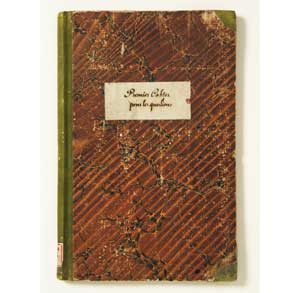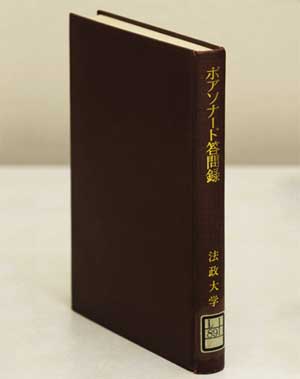FY2011
Vol.31 "Boissonade Answer Record" -Correspondence with Mr. Boissonade- (Hosei University Library)
December 22, 2011
FY2011 One day in April 1875, Boissonade, a legal advisor to the Meiji government, was on his way from his home to give a lecture at the Law School of the Ministry of Justice when he happened to witness the scene of torture at a courthouse he was passing. Alarmed by the horrific scene, Boissonade protested in tears to those involved, and it is said that when he returned home that day, he immediately wrote a letter to the Lord Chief Justice, Takatomo Ohki, calling for the abolition of torture.
The letter to the Lord Justice is well known along with the letter of reasons submitted a month later, in which he stated that he wanted to abolish torture. The notebook contains a copy of the original text of the two editions. The notebook contains 165 pages of original French transcriptions of Boissonade's answers to legal questions from the Meiji government from May 1875 to February 1976, as a "Record of correspondence with Mr. Boissonade.

The correspondence appears to have been compiled and transcribed by Japanese officials from Boissonade's words and letters, and although there are notable errors, each item is numbered from 1 to 42 (4 is missing) and dated. In 1875 and 1976, when the correspondence was conducted, the work of compiling the Code of Criminal Law, which had begun with the Penal Code and the Code of Criminal Jurisdiction, was just getting underway, and many of the items in the correspondence are related to criminal law.

Letter to His Lordship the Attorney General (April 15, 1875) (left), calling for the abolition of torture, and the first part of the "Confession on the Abolition of Torture (May 20, 1875)". In his Founding Proposal, Boissonade argues in detail that torture should be abolished from four perspectives: humanity, natural law and absolute justice, pure reason, and the dignity and interests of Japan. It is highly regarded as a historical document of universal value that fundamentally answers the question of why torture is wrong.
The correspondence seems to be mostly exchanged with Takeshi Inoue, who was then in a key position in the Ministry of Justice, and includes such well-known items as "Opinion on the Draft Ordinance of the Grain Exchange," in addition to those related to the abolition of torture. Among them, the question-and-answer session titled "In the absence of codified law, should custom be given more authority than equity? This document served as confirmation.
Answering government questions was one of the key responsibilities assigned to Boissonade at the time. Although many of the records are now in manuscript form in legal libraries and elsewhere, few of the supposed originals of the volumes in the notebooks have survived. Moreover, the manuscripts are all translations, making the notebooks an important source for understanding the original French text. At the same time, it is an extremely valuable source for understanding the role played by Boissonade in the process of Japanese legal modernization during the Meiji era.

Boissonade's Answer Record" (1978, Hosei University Press), a reprint of "Premier Cahier pour les questions" with translation, as part of a project commemorating the centennial of Dr. Boissonade's visit to Japan in 1873 as a legal advisor to the Meiji government.
Reference: Yasuho Okubo, "Boissonade" (1977, Iwanami Shinsho)
The following links will take you to previous "HOSEI MUSEUM" articles.

